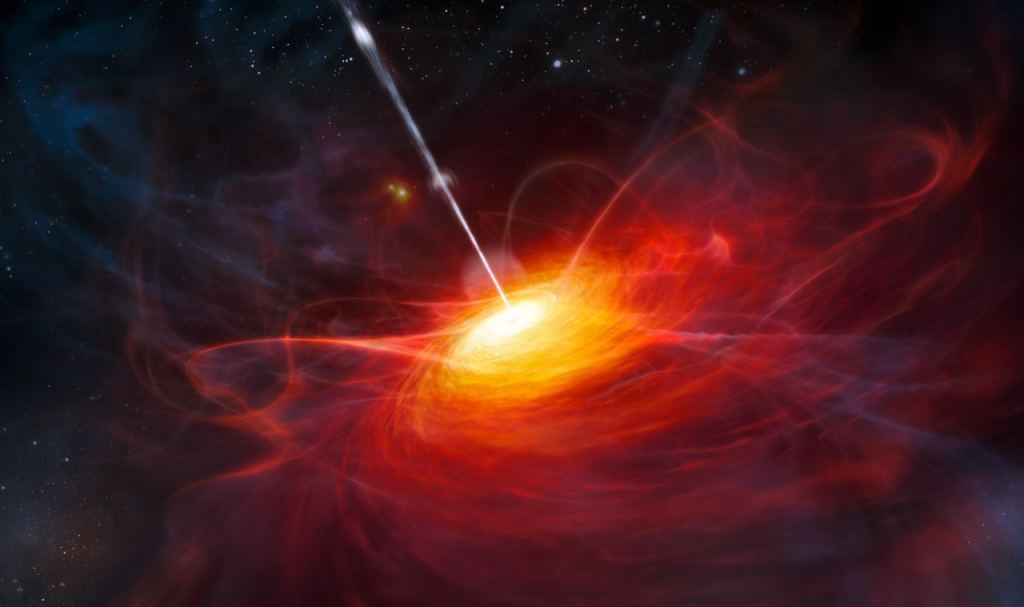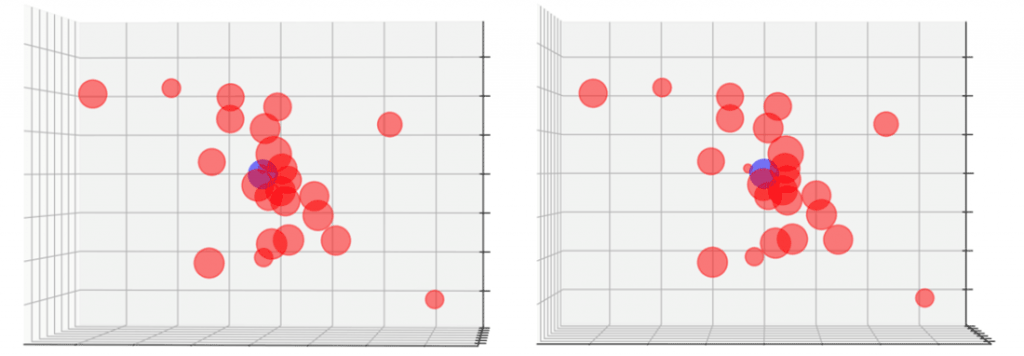One of the fundamental questions in astronomy is how galaxies formed over 13 billion years ago and have evolved ever since. A common feature that astronomers have noted is that most galaxies appear to have supermassive black holes (SMBHs) at their center – like Sagittarius A*, the ~4 million solar mass SMBH at the center of the Milky Way. These monster black holes occasionally swallow up nearby gas, dust, and stars and emit excess energy as powerful relativistic jets. This phenomenon, where the center of a galaxy outshines the stars in the disk, is known as an Active Galactic Nucleus (AGN) or quasar.
In a recent study, an international team of astronomers led by the European Southern Observatory (ESO) discovered a galaxy in the early Universe that could reveal more about this evolution. Using the Very Large Telescope (VLT) and the Atacama Large Millimeter/submillimeter Array (ALMA) in Chile, they observed a swarm of galaxies orbiting a very bright and vigorously star-forming galaxy in the early Universe. These observations provide fresh insight into how exceptionally bright galaxies grow and evolve into quasars and emit powerful jets of light across the observable Universe.
The research was led by Michele Ginolfi, a Research Fellow with the European Southern Observatory (ESO) in Garching, Germany. He was joined by researchers from the National Institute for Astrophysics (INAF), the Cavendish Laboratory, the Kavli Institute for Cosmology, the Max Planck Institute for Astrophysics (MPIA), the Cosmic Dawn Center (DAWN), the Niels Bohr Institute (NBI), the Paris Institute of Astrophysics (IAP), and multiple universities. The paper that describes their findings recently appeared in the journal Nature Communications.
Originally observed in 1963, quasars (short for quasi-stellar objects) were so-named because they resembled stars but shined brightly in the radio spectrum. Today, the term is used to describe all supermassive black holes that are particularly luminous because of how they consume surrounding gas, dust, and stars. Today, many details about how galaxies transition from being “normal” to quasars are still unknown. To learn more about this process, Ginolfi and his colleagues examined W0410-0913, one of the brightest, most massive, and gas-rich galaxies observed in the early Universe.
Located roughly 12 billion light-years from Earth, this galaxy appears to astronomers as it was about 1 billion years after the Big Bang. What makes W0410-0913 so bright is how dust is heated by its central black hole and the stars surrounding it. This makes this type of galaxy appear particularly bright in the infrared spectrum, leading to the designation “hot dust-obscured galaxies” (aka. “hot DOGs”). As Ginolfi explained in a recent press release from the Niels Bohr Institute:
“Before evolving into a full-blown quasar, some galaxies are thought to go through a phase of being very dusty, and very ‘active’ in terms of star formation and accretion of gas onto their central, supermassive black holes. We set out to design an experiment to learn more about this transition phase.”
Since the evolution of galaxies is connected to its surroundings, Ginolfi relied on data obtained by the Multi Unit Spectroscopic Explorer (MUSE) instrument at the Very Large Telescope (VLT) in Chile, which allowed them to study a region 40 times wider than the galaxy itself. They then consulted archival data obtained by the ALMA array, enabling them to measure the internal motion of the gas inside W0410-0913. As Peter Laursen, a researcher with the Cosmic Dawn Center in Copenhagen and a co-author on the study, explained:
“The observations revealed that W0410-0913 is surrounded by a swarm of no fewer than 24 smaller galaxies. The cool thing about the MUSE instrument is that we can measure not only their position on the sky, but also their distance along our line of sight. In other words, we can measure their 3D positions.”

This implies that W0410-0913 resides in a region at least ten times denser than the average Universe. This was not entirely unexpected since hot DOGs are theorized to reside in dense environments. What’s more, W0410-0913 was already ten times as massive as our galaxy when the Universe was about 1/8th the current age of the Universe. Achieving this level of growth in such a short space of time, and feeding a supermassive black hole to achieve this level of brightness, would require a substantial amount of feed material.
This is consistent with established theories about how massive galaxies grow by accreting gas and merging with satellite galaxies through gravitational attraction. In the dense environment that W0410-0913 occupied, the research team expected that it would be subject to interactions and mergers with other galaxies at a very high rate. They further anticipated that the galaxy’s interior would be a chaotic mess of whirling clouds of gas and stars. In this respect, they were surprised when the ALMA observations revealed that W0410-0913 did not appear to have been disturbed at all by interactions with its neighbors.
In fact, the ALMA observations showed that gas and stars rotated in an orderly fashion around the central black hole, though it moved at an incredible velocity – at 500 kilometers per second (1.8 million km/h; 1.12 million mph)! Said Ginolfi:
“Coupling the results from the two very different telescopes, we see a picture of how the most massive and dusty galaxies may evolve. This type of galaxies, a vital stage in the transition from a dusty and star-forming galaxy to a quasar, tends to grow in very dense environments. Nevertheless, despite the expected frequent merging with other galaxies, these gravitational interactions are not necessarily destructive — they feed the central galaxy and whirl up the gas a bit, but leave it practically intact. A bit like throwing small pebbles against a pane of solid glass: you may scratch it, but won’t break it…“

These observations provide insight into how galaxies in the early Universe evolved into what we see with the Milky Way’s neighbors today. It also provides the first clues regarding the processes that drive the evolution of hot DOGs, an extreme and rare population of galaxies in our Universe. From what Ginolfi and his colleagues gathered using the VLT and ALMA, these galaxies grow in special, dense habitats but can still interact with their companions gently. In the coming years, there will be many opportunities for follow-up observations of this and other early galaxies using next-generation telescopes.
This includes the James Webb Space Telescope (JWST) and the successor to the venerable Hubble – the Nancy Grace Roman Space Telescope (RST) – that is scheduled to launch in 2027. There are also the next-generation ground-based telescopes that will be joining the VLT and ALMA, including the ESO’s Extremely Large Telescope (ELT) and other 30-meter (foot) aperture instruments, like the Giant Magellan Telescope (GMT) and Thirty Meter Telescope (TMT). Knowing the intricacies of how galaxies evolved is also expected to provide fresh insight into Dark Matter, Dark Energy and lead to more comprehensive models of cosmic evolution.
Further Reading: Neils Bohr Institute, Nature
The post A Galaxy With Ten Times the Mass of the Milky Way is Preparing to Become a Quasar appeared first on Universe Today.
No comments:
Post a Comment